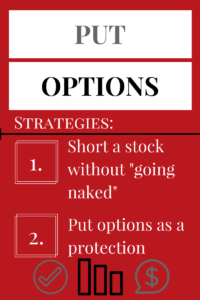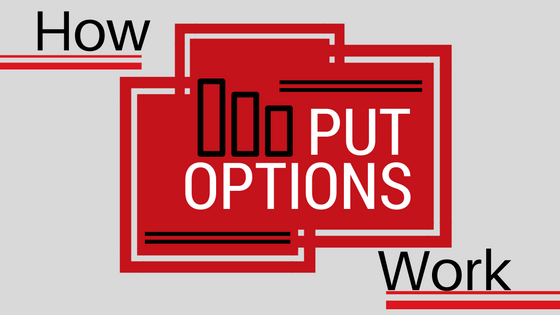What Are Options – Part II
In the previous post, we discussed the first of the two type of options: call options. In this post, we are going to break down what put options are and how they work.
Now to recap an option, in its simplest form, is a contract to buy or sell a specific stock at a specific price for a specific amount of time.
In order to have an option contract, it must contain the following components: 1. an agreement to buy or sell stock 2. a set price 3. a specific amount of time and 4. a cost. With those components, you have an option contract.
Note: You can also listen to the podcast on these forums by clicking the icon:
Understanding Put Options
While you can be both a buyer and a seller of options, in this post we will focus on the buyers view. A put option contract is an option to “put” or sell stock to someone at a certain price for a specific amount of time. In it’s simplest form, you can “force” someone to buy stock from you.
When you compare a call option to a put option there a few key distinctions.
Buying a call option is a bullish strategy in which you have the right to purchase the stock from someone (the seller of the call option) at a certain price in the future. You are hoping the stock goes above the price that you have the right to buy it for so that you can exercise your option to buy the stock, and then turn around and sell it on the open market at the higher price, ideally locking in a profit.
A put option is the opposite of the call option
Buying a put option is a bearish strategy in which you have the right to force someone (the seller of the option) to buy stock from you at some point in the future only in this scenario you are planning on the stock falling. Now there’s more to it as you may be thinking, “Well what if I don’t own the stock? How do I make money from the stock falling?” or “Why would anyone agree to let me force them to buy stock from me?”
Below we will discuss some examples and strategies, but for now just know that with a put option you are anticipating the stock falling which makes it a bearish strategy and that you can force someone to buy stock from you. To say it another way, you have the right to “put” the stock to the person who sold you the put option. That’s the risk the seller takes is that they may be at some point forced to buy a certain stock.
For example… by owning a car, you are already participating in a form of a put option. Let’s say your car is a 2016 Mercedes Benz or whatever your favorite car is. In order to drive that car, you have to put insurance on it. Every month, you have to write a check to the insurance company, for example $200. What you are saying to the insurance company is: “When I write this check for $200, I am buying a put option so if I get in an accident tomorrow and total the car and value immediately went to a total loss, you still have to buy the car from me”. It was worth $100,000 but now it is zero. But because you have an “insurance policy”, aka a put option contract, they are forced to pay for it. What is in it for them? They get $200 a month, and if you don’t get in an accident that is what they get. What is in it for you? You get protection from loss and can force someone to buy it in case you do get in an accident. It is the same with a put option.
Put Options as a Strategy
Although there are many uses for a put option, there are two main strategies and uses for them.
Strategy #1 – Short a stock without going naked
Now what the heck does short a stock mean and why are we talking about getting naked? Don’t worry I’ll explain. Shorting a stock means to agree to sell something that you don’t own at a higher price in hopes that the price falls so you can buy the stock you originally agreed to sell when it’s time to do so.
You basically are saying, “Hey want to give me $50 for stock ABC?” (although you don’t actually own stock ABC but have the ability to go buy it). When you enter into that agreement you are considered “Naked” or “Uncovered” because you don’t own the stock. If stock ABC drops down to $40 you would ideally go buy stock “ABC” for $40 bucks and then give it to the other guy who already agreed to buy it from you at $50. So you are hoping that the stock will fall by $10, so when you sell it you are making $10.
If you were to go the route of shorting stock by going naked you expose yourself to unlimited risk. Because you don’t actually own the stock and are hoping it falls to a lower price so you can buy it and deliver on your promise, your risk is to the upside because there is a chance that the stock won’t go down but it may actually go up and keep going up which means you would have to buy at a higher price and sell it a lower price to meet your obligation.
Here comes put options to save the day. Instead of going naked and having unlimited upside risk, you could short the same stock by buying a put option. The key difference is that you have limited risk since you can never lose more than the amount you paid for the put options.
For example with your car, you paid $200 a month to the insurance company in case of a wreck. At the end of 30 days, you will never lose more than the $200. You already have an agreement at that price.
To sum up strategy 1, just know that shorting stock has unlimited risk to the upside and by using a put option to short a stock you are limiting your risk to only what you paid for the option. It doesn’t matter how high the stock goes, you’ll never risk more than what you paid for the option.
To drive home the point ask yourself this question: “Would I rather take a position that has unlimited risk or limited risk?” The answer should be obvious.
Strategy #2 – Put options as protection
This is one of the single most important strategies that I think most people ignore and that is how to protect their trading or investment portfolio.
When you own a large amount of stock or have a decent size investment account you should be thinking, “How do I protect this money from disappearing?” Put options allow you to do just that. With this strategy, you have the ability to buy a put option and lock in your account value from any major sell offs.
 As a real life example, think about life insurance. Let’s say you have a 30-year $500,000 policy. You write a check every month that says that if something happens to you, you get a check for $500,000. If you have a house or car or kids and pass away too early before you secure this, life insurance protects the value of what you can produce as a working person. Put options protect and lock your account in very similarly…
As a real life example, think about life insurance. Let’s say you have a 30-year $500,000 policy. You write a check every month that says that if something happens to you, you get a check for $500,000. If you have a house or car or kids and pass away too early before you secure this, life insurance protects the value of what you can produce as a working person. Put options protect and lock your account in very similarly…
Let’s look at an example. Let’s say you own 1,000 shares of stock XYZ at a price of $300 for a total investment account size of $300,000. When you use put options as protection, you could buy a $290 put option on stock XYZ and for a certain period of time. This contract says, “I have the right to sell my XYZ stock at $290 no matter what happens”.
Example continued… Imagine some bad news came out on the stock or maybe they had bad earnings and the next day the stock falls from $300 down to $200. In a normal world you would lose $100,000 since you own 1,000 shares and there would be nothing you could do about it. But if you had a $290 put option and the stock fell down to $200 you could still force someone to buy your stock from you at $290. In this scenario, you would only lose $10/share on 1,000 shares so $10,000.
There’s a big difference between losing $10,000 and losing $100,000. Major losses can be avoided by learning how to apply these option strategies.
Yes you might have spent $3,000 to protect, like your insurance, but the big picture is it protects your $300,000 account.
To wrap up this section on strategy number two, the key takeaway is not that you are trying to make money with the put option like you did in strategy number one, but you are trying to preserve your trading account from any catastrophic losses.
“Put”ing It All Together
There are three main concepts that I want you to take away from this post with respect to options and specifically put options.
- Knowing how and when to use options in your trading can drastically increase your chances of limiting risk and accelerating profit.
- Put options can be used to to make money on the downside, which we know stocks do not always go up and there is a way to capitalize on that movement with limited risk.
- If you already have a thriving trading account, put options can be used as protection during a market sell off or one time events like earnings to help prevent your account from going from hero to zero.
There are a lot more benefits and strategies to call and put options, but there is only so much I can dive into in a blog post.
 If you want to learn more about call and put options and how to increase your chance of consistently making a profit, check out my Options Explained course here www.PowerTradesUniversity.com
If you want to learn more about call and put options and how to increase your chance of consistently making a profit, check out my Options Explained course here www.PowerTradesUniversity.com
I walk you through buying and selling, how to protect your stock if you own it, and a lot more.
You also get access to our private Facebook group with hundreds of like minded traders to ask questions and bounce ideas off of.


